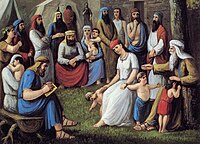
The Book of Helaman is one of the books that make up the Book of Mormon, a text held sacred by churches within the Latter Day Saint movement, including the Church of Jesus Christ of Latter-day Saints. The book continues the history of the Nephites and the Lamanites from approximately 50 BC to 1 BC. It discusses political unrest among the Nephites and the formation of a group of secret dissenters called the Gadianton Robbers. Helaman, son of Helaman leads the Nephites for a time, and his sons Nephi and Lehi go on a successful mission to the Lamanites. When Nephi returns home, he correctly identifies the murderer of the chief judge using his prophetic powers, and sends a famine to the Nephite which lasts three years. After a digression from Mormon, the book of Helaman ends with Samuel the Lamanite's prophecy of the signs that will precede Christ's birth and death. Helaman deals with themes of external and internal conflict, hidden information, Nephite racism, and Mormon's views of history as deduced by his redaction of it.

In the Book of Mormon, the Nephites are one of four groups said to have settled in the ancient Americas. The term is used throughout the Book of Mormon to describe the religious, political, and cultural traditions of the group of settlers.

The Book of Mormon mentions three men named Helaman. The first was the son of King Benjamin, king of the united Nephite-Zarahemla kingdom who lived in the 2nd century BC. Besides his genealogy, information about the first Helaman is limited. His brother, Mosiah, became heir to the throne.

Mulek, according to the Book of Mormon, was the only surviving son of Zedekiah, the last King of Judah, after the Babylonian conquest of Jerusalem. The Book of Mormon states that after escaping from Judah, Mulek traveled to the Americas and established a civilization there.

In the Book of Mormon, Alma, the son of Alma is a Nephite prophet often referred to as Alma the Younger to distinguish him from his father, who is often referred to as Alma the Elder. These appellations, "the Younger" and "the Elder," are not used in the Book of Mormon; they are distinctions made by scholars, useful because both individuals were prominent during the same time period in the Book of Mormon's story and filled a similar cultural and religious role. Alma is the namesake of the Book of Alma.

According to the Book of Mormon, the Anti-Nephi-Lehies were an ethnic group of Lamanites formed around 90 BC, after a significant religious conversion. They made a covenant that they would not participate in war, and buried their weapons. Eventually they changed their name to the people of Ammon, or Ammonites. During a later period of warfare, the young men of the group who had not made the pacifist covenant became a military unit known as the two thousand stripling warriors, and were protected by divine intervention.

According to the Book of Mormon, the plates of Nephi, consisting of the large plates of Nephi and the small plates of Nephi, are a portion of the collection of inscribed metal plates which make up the record of the Nephites. This record was later abridged by Mormon and inscribed onto gold plates from which Joseph Smith translated the Book of Mormon after an angel revealed to him the location where the plates were buried on a hill called Cumorah near the town of Palmyra, New York.
This chronology outlines the major events in the history of the Book of Mormon, according to the text. Dates given correspond to dates in the footnotes of the Church of Jesus Christ of Latter-day Saints edition of the Book of Mormon and to a Jaredite timeline proposed by Latter-Day Saint scholar John L. Sorenson.

Daniel Webster Jones was an American and Mormon pioneer. He was the leader of the group that colonized what eventually became Mesa, Arizona, made the first translation of selections of The Book of Mormon into Spanish, led the first Mormon missionary expedition into Mexico, dealt frequently with the American Indians, and was the leader of the group that heroically wintered at Devil's Gate during the rescue of the stranded handcart companies in 1856.

According to the Book of Mormon, Moronihah was the son of Captain Moroni who had defeated the armies of Zerahemnah, stopped the king-men, and restored the Nephites' cities to their possession. When Moroni got too old to lead an army any longer, Moronihah received command of his father's armies.

Aminadab is a person in the Book of Mormon who appears in the Book of Helaman. He had been a member of the Nephite church but left it and became associated with the Lamanites. In the Book of Helaman, after Nephi abdicates the Chief Judgment Seat to Cezoram, he and his brother Lehi go to preach to the Lamanites, who imprison them. After a heavenly incident, Aminadab clarifies to the surrounding Lamanite captors that Nephi and Lehi are conversing with angels.

The Gadianton robbers, according to the Book of Mormon, were a secret criminal organization in ancient America.

The following outline is provided as an overview of and topical guide to the Book of Mormon:

According to the Book of Mormon, Coriantumr (/ˌkɒriˈæntəmər/) was a Nephite dissenter and Lamanite captain. Coriantumr led the Lamanite armies against the Nephites in an attempt to conquer the land. He was countered by Moronihah and Lehi, eventually dying in battle.




